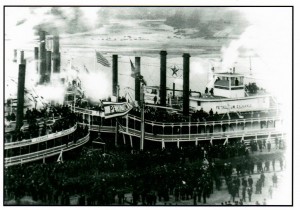Steamboating had a long standing reputation as a high risk business. In 1868, a US Treasury Department report indicated that 96 of the 1,042 inspected steamers on inland rivers were lost. That was a 9.2% rate of loss. Of the 96 boats lost, the single greatest cause was snagging. The following table lists the number and percentage of boats lost per cause.
| Cause | No | Pct |
| Sank, mostly by snagging | 51 | 53.1 |
| Burned | 29 | 30.2 |
| Exploded | 9 | 9.8 |
| Collisions | 7 | 7.3 |
In 1868, 4 of the 62 boats (6.5%) leaving St Louis for the upper Missouri were lost. All were snagged and total losses. The Amelia Poe owned by Thomas W Poe of Georgetown, PA was one of the four casualties in 1868. [1]
The Steamboat Act of 1852 attempted to improve river transportation safety and reduce the loss of civilian lives due to boiler explosions by annual inspections and licenses for boats, pilots, and engineers. Less than one percent of the boats on inland rivers exploded in 1868. However, the loss of life from fire and scalding water made sensational news. Boatmen, ever practical business men, supported river improvements as their preferred method to improve safety. Removal of snags and channel improvements would make river navigation safer and reduce costs of shipping for government and private businesses. The facts support the river improvement advocates. Action did not happen. Although snag boats were built with federal assistance, channel improvement such as rock removal in the Dauphins Rapids did not occur until the 1870s. The first lock and dam on the Ohio River was not built until 1885.

Davis Island Dam opeining ceremony, Ohio, Oct. 7, 1885. Taken during the opening ceremony at the dam. C. W. Batchelor has star between stacks. (From the Collection of the Public Library of Cincinnati and Hamilton County)
George WE Poe was a pilot of the CW Batchelor during this time, but whether he was the pilot the day of the ceremony is unknown.
References.
[1] William E Lass, Navigating the Missouri/ Steamboating on Nature’s Highway, 1819-1935, (University of Oklahome Press,2007), p 257.
Tags: georgetown, steamboat